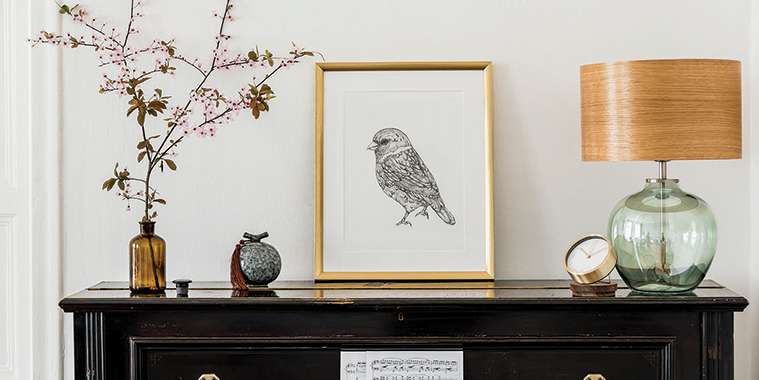Comfort has been a top design trend this past year, and with good reason. With a global pandemic and more time being spent at home than ever before, it’s relaxing — and necessary — to escape into a simpler version of our current uncertain reality.
Imagine a moss-covered cottage in the center of a meadow beside a stream where chickens and goats wander freely. You just put a pie out on the windowsill to cool and picked some beans in your garden before going to sit on your rocking chair on the porch to crochet a pretty tea cozy. Comfort, sustainability and a return to nature are all emphasized in this idyllic scene. Feeling more relaxed? That’s cottagecore at work.
The current cottagecore trend started around 2010 on social media with people connecting through the sharing of nostalgic, rural-inspired images. However, the origins of cottagecore are much older, beginning when European nobility sought simpler lives through country living. Similarly, today’s cottagecore aesthetic celebrates rural life, growing significantly in popularity during the pandemic as a romanticized way to escape the worries of the day.
What a cottagecore home looks like
A cottagecore home should be a place of comfort, reflection and function with lots of natural light. Along with potted plants, rustic furniture, vintage decor and other nostalgic touches, homes decorated in this style often show signs of a self-reliant lifestyle, with dried herbs in the kitchen or a wicker foraging basket hanging on the porch. Despite promoting a simpler lifestyle, the cottagecore trend doesn’t share minimalism‘s focus on negative space and clean lines. Cottagecore actually embraces some clutter as a sign of life. Things like skeins of yarn kept in a basket by a rocking chair, ingredient jars left out on the counter, or a handy stack of books on the bedside table are all more than welcome in a cottagecore home.
Keeping the spirit of the cottagecore lifestyle in mind, here are some design basics to consider while you decorate your cottagecore home.
Layer natural materials
Cottagecore and nature go hand in hand, which is why homes decorated in this style should make use of wood, wicker, hemp, and other natural materials. Whether it’s a basket for extra blankets, wooden stools at the kitchen counter, or a macrame piece made of hemp, furniture and decor made from these materials are central to the cottagecore trend.
Opt for vintage furniture
Antique furniture — especially those with a rustic farmhouse look or French influence—are some of the most essential items in cottagecore home design. Vintage decor not only works well with the style’s look, but also helps create the nostalgic vibe cottagecore is known for. And don’t worry about chipped paint or faded fabric. Similar to farmhouse decor, these so-called imperfections add to your cottagecore home’s charm.
Play with colour & texture
Earth tones and floral patterns pair perfectly with the cottagecore aesthetic. Where many modern home design styles utilize monochromatic color schemes and sleek lines, the cottagecore trend relies on a more eclectic mix of color and texture. Think lace cloth on wooden tables, quilted throws atop crushed velvet chairs for texture, and earth tones mixed with greens and floral-inspired pastels.
Let spaces feel lived in
While no one likes an overly cluttered home, having signs of life in your living space is a major component of the cottagecore style. Why worry about hiding away cookware when you can use it as decor between uses! And why not do the same with a few of your favorite books? Leaving certain comforts out for all to see not only makes them easier to access, but will give your cottagecore home a certain cozy charm as well.
Hang wallpaper
As far as cottagecore is concerned, wallpaper is back in style. Vintage wallpaper makes a stunning backdrop to cottagecore decor, particularly if it’s floral or nature-inspired. And if you don’t want to deal with the hassle of putting up real wallpaper, there are several faux wallpaper options on the market that look just as good. Even just covering an accent wall with a whimsical print can help nudge your home’s cottagecore transformation in the right direction.
Add plush furnishings
Cozy throws, overstuffed pillows, long curtains, and other soft furnishings can make a house feel like home. So use a rug to warm up wooden floors, and add a couple quilts to keep your couch extra comfortable. Cottagecore homes should feel just as welcoming as they look.
Create your own pieces
On top of providing great health benefits, plants are a simple and relatively inexpensive way to beautify your home. Since the cottagecore aesthetic is meant to recall agrarian culture, bringing greenery indoors is ideal for home decor. Displaying a vase of fresh-cut flowers is one way to emphasize cottagecore’s ties to nature. To go the extra mile, try finding plants and flowers that are native to where you live.
Put ingredients on display
Cooking, baking, and other home-making activities have strong associations with the cottagecore lifestyle. Leaving out dry ingredients, herbs, produce, and other items that don’t require refrigeration can be both convenient and aesthetically pleasing in your home’s interior. Place fruit in suspended bowls, hang some dried aromatics above the counter, or keep your spices in decorative jars.
Include rustic wall art
Round out your space with some country-themed wall art. Nature prints, polaroid photographs, landscape paintings, and other nostalgic pieces make ideal decor choices for any cottagecore home. And these items provide a chance for you to further personalize your space.
By following these simple design tips and you’ll be feeling cottagecore-calm in no time.



